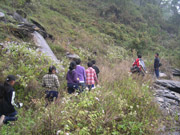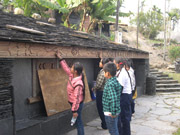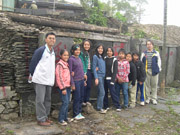The traditional buildings of the Taiwanese aborigines are built according to environmental needs and uses local materials. Since southern Taiwan’s mountainous areas have an abundance of naked stones these slabs could be obtained easily, Paiwan Tribe’s houses have used it as the main building material to build the slabstone houses, which has also become the tribe’s unique cultural symbol.

Other than using wood for the beam-column and eaves, all other parts are built with stone slabs, and due to its small windows the interior may seem dark. In the past the tribesmen dug vertical holes lined with slabs under the floor to bury deceased family members in the squatting position. Chieftain and royalty houses were decorated with patterns to show their status.

Construction process:
-
Harvesting stone slabs: The Paiwan tribesmen used sharp poles to make a crack on a corner of the slab, afterwards a metal clip was used to split the slab and ropes are then used to secure the slab for transportation, which in the past was done on the bare-backs of tribesmen but now are performed with mechanical lifters and trucks.
-
Beating the slabs: The slabs removed from rocks are irregular in shape and the tribesmen would use metal hammers and rods to knock off slab edges and make appropriate sizes.
-
Clearing the foundation: Before constructing the house the tribesmen will first dig a trough out of the hill to form the foundation for the slabstone house - generally rectangular in shape.
-
Building slab walls: The houses are built along the hill, therefore only the front wall is formed by a slab while both the sides and back walls are shaped by layers of slabs.? The back wall serves to protect against landslides while the side walls are weight-bearers. Two slanted slabs are found under the eaves to prevent the house from collapsing forward and since the back wall is against the hill the houses do not tilt. The front wall is a thin wall formed by erecting a large slab sheet, with shorter slabs for windows and areas with no slab for the door. The floor and entrance are also covered with slabs.
-
Erecting the Spirit Pole: The habit of erecting spirit poles are practiced in the houses of chiefs and royalty and enlists the help of tribesmen. Ropes are first tied on the top part of the pole and with everyone’s help the pole is pulled upright. The poles are often decorated with ancestral figures and snake patterns and forms the physical symbols of ancestors. In the Majia and Lili villages of Paiwan Tribe stone poles were erected in royalty houses, and since stone lasts longer than wood and their decorations are very traditional, perhaps it is their oldest tradition.
-
Laying the Roof: The rooftops are lined by overlapping stone discs covered by stones or bamboo and lined with grass underneath. After laying the roof the house is considered complete.
Researched and recorded by: Hsiao-ning, Hsiao-rong, Hsiao-rou, Hsiao-wen

Top |
